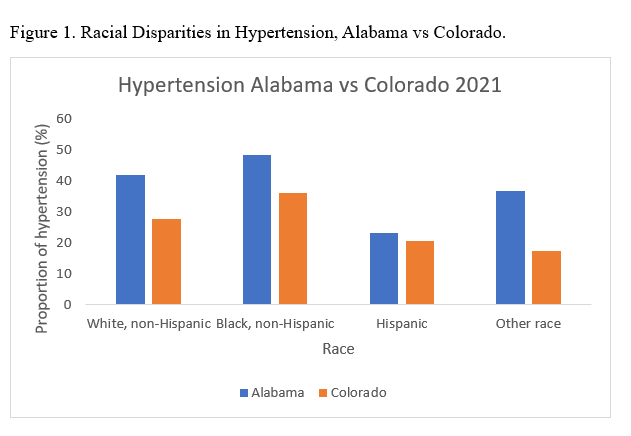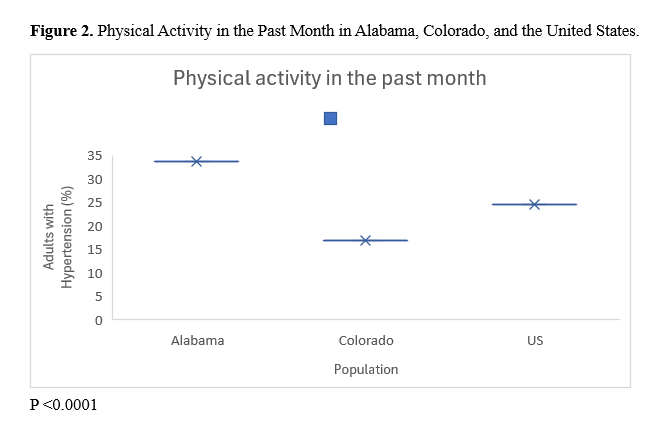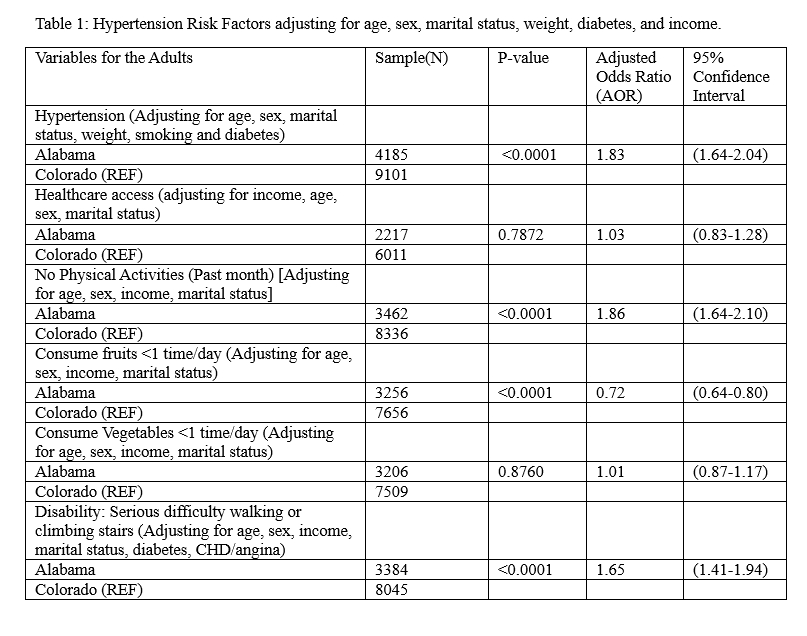Final ID: P2065
A Comparative Study Of Social Determinants, Hypertension, And Life Essential Factors In Alabama And Colorado From The 2021 Behavioral Risk Factor Surveillance System
Abstract Body: Background: Hypertension is an important modifiable risk factor for cardiovascular disease, which disproportionately impacts racial/ethnic minorities in the US. Currently, Equity in Prevention of Hypertension (EPIPHANY, 2024) a program funded by the American Heart Association(AHA) is focusing on and engaging the Black belt of Alabama to mitigate hypertension by targeting adults with prehypertension, a new strategy to reduce the prevalence of hypertension. This project was meant to test the hypothesis of no difference in the risk of hypertension between two US States and to generate evidence for implementation.
Objective: To compare the social determinant of health (SDOH), hypertension, and the AHA life's essential factors among adults in Colorado and Alabama in the 2021 Behavioral Risk Factor Surveillance System (BRFSS)
Methodology: This was a cross-sectional survey of adults enrolled in the US 2021 BRFSS study. Data analysed compared Colorado and Alabama to determine the essential life factors among the two states. Elevated blood pressure (hypertension) and the included variables were based on the answers from the diagnosis of the healthcare professional given to the participants in the US BRFSS 2021. Data analysis used regression and risk ratios from the BRFSS WEAT to calculate the logistic regression and adjusted odds ratios (CDC, 2024).
Results: In 2021, the racial proportion of adults with hypertension in Alabama was 41.8% for White vs 48.4% for the Black population (overall proportion=42.6 %), while in Colorado, 27.6% of White vs 36.1% of the Black adult population had hypertension(Overall proportion=25.9%) [Figure 1]. Compared to Colorado, AL has 1.83 times higher AOR of hypertension (p<0.0001). Fruit consumption, physical activity, and disability status significantly differed between Alabama and Colorado (p<0.0001)[Table 1, Figure 2]. Surprisingly, there was no difference in healthcare access between AL and CO (0.7872) [Table 1]
Conclusion: Though Colorado has the lowest prevalence of hypertension in the United States, disparities still persist. However, Alabama demonstrated much higher disability status, lack of physical activity, and consumption of vegetables and fruits of <1 time/day (p<0.0001).
Recommendations: The high burden of hypertension among ethnic minorities deserve attention and more evidence can be assessed to further understand the enabling factors that led to CO having the lowest proportion of hypertension.
Objective: To compare the social determinant of health (SDOH), hypertension, and the AHA life's essential factors among adults in Colorado and Alabama in the 2021 Behavioral Risk Factor Surveillance System (BRFSS)
Methodology: This was a cross-sectional survey of adults enrolled in the US 2021 BRFSS study. Data analysed compared Colorado and Alabama to determine the essential life factors among the two states. Elevated blood pressure (hypertension) and the included variables were based on the answers from the diagnosis of the healthcare professional given to the participants in the US BRFSS 2021. Data analysis used regression and risk ratios from the BRFSS WEAT to calculate the logistic regression and adjusted odds ratios (CDC, 2024).
Results: In 2021, the racial proportion of adults with hypertension in Alabama was 41.8% for White vs 48.4% for the Black population (overall proportion=42.6 %), while in Colorado, 27.6% of White vs 36.1% of the Black adult population had hypertension(Overall proportion=25.9%) [Figure 1]. Compared to Colorado, AL has 1.83 times higher AOR of hypertension (p<0.0001). Fruit consumption, physical activity, and disability status significantly differed between Alabama and Colorado (p<0.0001)[Table 1, Figure 2]. Surprisingly, there was no difference in healthcare access between AL and CO (0.7872) [Table 1]
Conclusion: Though Colorado has the lowest prevalence of hypertension in the United States, disparities still persist. However, Alabama demonstrated much higher disability status, lack of physical activity, and consumption of vegetables and fruits of <1 time/day (p<0.0001).
Recommendations: The high burden of hypertension among ethnic minorities deserve attention and more evidence can be assessed to further understand the enabling factors that led to CO having the lowest proportion of hypertension.
More abstracts on this topic:
Association of Gender with Self-reported Physical Activity Among Younger Persons After a Myocardial Infarction
Suvada Kara, Jain Vardhmaan, Razavi Alexander, Shah Amit, Vaccarino Viola, Elon Lisa, She Hua, Krafty Robert, Lobelo Felipe, Osei Jeffery, Gold Matthew, Yadalam Adithya
2 Dimensional Echocardiography versus 3 Dimentional Echocardiography to Assess Right Ventricular Function in Pulmonary Hypertension: A Systematic ReviewChaudhry Waleed Razzaq, Hajj Fatima, Bathula Satyamedha, Meghji Mohammed Askari, Pasupuleti Hemalatha, Kiyani Madiha, Shah Syeda Simrah, Neelakantan Ramaswamy Sanathanan, Mirzaeidizaji Nakisa, St. Jacques Jahnoy, Khan Khalil Ullah, Veluchamy Elakkiya, Jesse Joshanna



